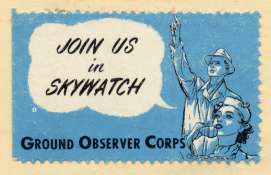Ground Observer Corps
The Ground Observer Corps, sometimes erroneously referred to as the Ground Observation Corps, was the name of two American civil defense organizations.
World War II Organization
The first Ground Observer Corps was a World War II Civil Defense program of the United States Army Air Forces to protect against air attack. The 1.5 million civilian observers at 14,000 coastal observation posts used naked eye and binocular searches to search for German and Japanese aircraft until the program ended in 1944.[1]
Observations were telephoned to filter centers, which forwarded authenticated reports to the Aircraft Warning Service which also received reports from the Army Radar Stations.
Cold War Organization


The second Ground Observer Corps[2] was reformed during the Cold War as an arm of the United States Air Force Civil Defense network which provided aircraft tracking with over 200,000 civilian volunteers. The corps was established in early 1950 to supplement the Lashup Radar Network and a permanent radar network[3] started with "ADC radar site" P-1 (McChord AFB) on June 1, 1950. "Filter centers" (e.g., in New Haven, Connecticut[4] and Baltimore, Maryland[2]) received telephoned voice information from 8,000 posts, and the information was relayed to Air Defense Command ground control interception centers.[5]
By 1952 the program was expanded in Operation Skywatch with over 750,000 volunteers at over 16 thousand posts (98 per post in shifts) and 75 centers. The program ended in 1958[6] with the advent of the automated 1959 USAF radar network (SAGE) and the automated Army networks (Missile Master). The first officially commissioned rural skywatch tower was the Cairo Skywatch Tower.[7]:5-6 It was listed on the National Register of Historic Places in 2002.[8]
GOC volunteers were encouraged to continue their service in the Radio Amateur Civil Emergency Service (RACES).
|
|
References
- ↑ Morgan, Mark L; Berhow, Mark A (2002). Rings of Supersonic Steel (Google Books) (second ed.). Hole in the Head Press. ISBN 0-615-12012-1. Retrieved 2011-09-13.
- 1 2 "Less Than Half Spotter Time Filled In Week" (Google News Archive). The Gettysburg Times. Times and News Publishing Company. April 5, 1954. Retrieved 2012-01-04.
- ↑ Winkler, David F (1997). Searching the skies: the legacy of the United States Cold War defense radar program. Prepared for United States Air Force Headquarters Air Combat Command.
- ↑ "News of Southington". Meriden Record. Meriden, Connecticut. 22 February 1954.
The meeting will be addressed by Lieut. Wenzel of the New Haven Filter Center,...
- ↑ Schaffel, Kenneth (1991). The Emerging Shield: The Air Force and the Evolution of Continental Air Defense, 1945–1960. Washington, DC: Office of Air Force History.
- ↑ "Filter Center 'In Reserve'". The Milwaukee Sentinel. Milwaukee, Wisconsin. 1 January 1958.
- ↑ "Indiana State Historic Architectural and Archaeological Research Database (SHAARD)" (Searchable database). Department of Natural Resources, Division of Historic Preservation and Archaeology. Retrieved 2016-07-01. Note: This includes John M. Harris, Angela Bowen, and Ben Ross (July 2001). "National Register of Historic Places Inventory Nomination Form: Cairo Skywatch Tower" (PDF). Retrieved 2016-07-01. and Accompanying photographs
- ↑ National Park Service (2010-07-09). "National Register Information System". National Register of Historic Places. National Park Service.